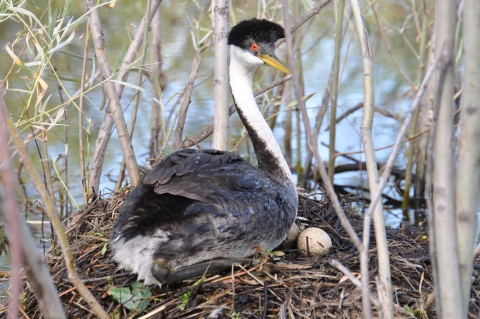About Us
Deer Flat National Wildlife Refuge is one of the oldest refuges in the National Wildlife Refuge System. It was established in 1909 to designate the new irrigation reservoir as a refuge and breeding grounds for migratory birds and other wildlife. The refuge now serves as an urban oasis for both wildlife and Treasure Valley residents and visitors.
Deer Flat National Wildlife Refuge has two units–-Lake Lowell and the Snake River Islands. The Lake Lowell Unit encompasses over 10,500 acres, including the almost 9,000-acre Lake Lowell and surrounding lands. The Snake River Islands Unit contains over 1000 acres on 104 islands. Refuge islands are distributed along 113 river miles from the Canyon-Ada County Line in Idaho, to Farewell Bend in Oregon.
The Refuge protects a wide range of wildlife habitats: the open waters and wetland edges of Lake Lowell, the sagebrush sagebrush
The western United States’ sagebrush country encompasses over 175 million acres of public and private lands. The sagebrush landscape provides many benefits to our rural economies and communities, and it serves as crucial habitat for a diversity of wildlife, including the iconic greater sage-grouse and over 350 other species.
Learn more about sagebrush uplands around the lake and the grasslands and riparian riparian
Definition of riparian habitat or riparian areas.
Learn more about riparian forests on the Snake River islands. The variety of habitats makes the refuge an important breeding area for resident and migratory birds, including providing one of the few nesting areas for western and Clark’s grebes in Idaho. The refuge is also a significant resting and wintering area for birds migrating along the Pacific Flyway, including spectacular concentrations of mallards and Canada geese. Because of its value to birds, Deer Flat National Wildlife Refuge has been declared an Important Bird Area by the National Audubon Society.
The refuge welcomes diverse communities to connect with nature and each other through free educational and outdoor recreational experiences.
Our Mission
The mission of the National Wildlife Refuge System is to administer a national network of lands and waters for the conservation, management and, where appropriate, restoration of the fish, wildlife and plant resources and their habitats within the United States for the benefit of present and future generations of Americans.
Every national wildlife refuge national wildlife refuge
A national wildlife refuge is typically a contiguous area of land and water managed by the U.S. Fish and Wildlife Service for the conservation and, where appropriate, restoration of fish, wildlife and plant resources and their habitats for the benefit of present and future generations of Americans.
Learn more about national wildlife refuge was created for a special purpose. Some were created to protect migratory birds, others to protect threatened or endangered species or unique habitats, while others fulfill another special purpose. All activities allowed on refuges must be evaluated to make sure each activity will not conflict with the reason the refuge was founded.
The purpose of Deer Flat National Wildlife Refuge is to serve as a refuge and breeding ground for migratory birds and other wildlife.
Our History
Deer Flat National Wildlife Refuge is one of the oldest refuges in the National Wildlife Refuge System. Here are some key dates in refuge history.
1906-1909 – Between 1906 and 1909, crews built two large and two small earthen embankments, or dams, to contain the Deer Flat Reservoir.
February 25, 1909 – The Deer Flat Bird Reservation was established by President Theodore Roosevelt as a refuge and breeding ground for migratory birds and other wildlife.
August 17, 1937 – The Snake River Migratory Waterfowl Refuge was established by President Franklin D. Roosevelt as a refuge and breeding ground for migratory birds and other wildlife.
July 25, 1940 – The refuges were renamed the Deer Flat National Wildlife Refuge and the Snake River National Wildlife Refuge.
June 28, 1963 – The two refuges were consolidated as two units of Deer Flat National Wildlife Refuge.



